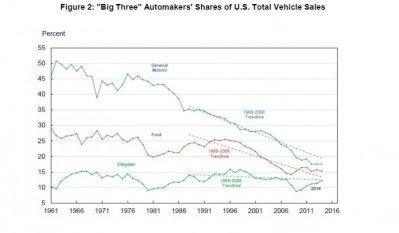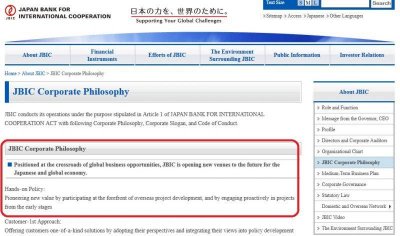Maybe just to refine a few points... Saying that I (and family) have had good luck with Chrysler products was not intended to spark a debate about good-bad-indifferent. I used Chrysler products as an example, but what I intended to convey was that painting with a broad-brush (Domestic Bad, Foreign Good) is stupid. Use the name of any manufacturer and then "problems.com" and you'll find weak links among all automakers. On a different tangent, launching an unsuccessful product, separate from quality problems, is often portrayed as another specialty of the D3. How many MSN.com or Cars.com internet articles are still crowing about the Pontiac Aztec, while stories about Toyota allowing dealers to drop their Scion franchises are page 53 in an automotive trade publication? I'm exposing the hypocrisy, but not minimizing the impact because the article's included chart is
absolutely stunning, especially for GM/Ford. The effect on Chrysler is almost irrelevant.

Secondly, it was not my intent to debate the validity of CAFE standards but to explain how government interference on the SUPPLY side (vs. demand), coupled with an inability to sell small cars outside of the NAFTA region, created the dependence upon trucks/SUVs as profit centers.
For a moment, let's pretend that it's 1975 and GM/Ford/Chrysler are the only big players in the market. Imports don't even exist. Government comes along and says "You guys need to build higher MPG cars, so we're going to starting imposing fines if your car MPG average doesn't increase. However, the farm/construction/utility/municipal, etc. lobby says they still need capable trucks with 8' beds, V8s and heavy frames, so we'll leave trucks alone." The voters like this because they feel like they're saving mother earth, but they're not paying an extra dime... Leave that problem for the car companies and let's go to the disco! :yaayy:
The D3 comply (to say they accept/agree is like saying we all enjoy paying taxes). Cars get smaller and lighter, and for a while you're even competing against your own used cars from a few years prior because they're more comfortable, capable, faster, and all the other nice things that use more fuel. There is no reason for the consumer to adapt, because except for an occasional spike, fuel remains cheap (unlike Europe and Asia). In fact, people "adapt" by hoarding old full-size sedans and station wagons because they're the only vehicles which can pull a boat or haul a big family. (Um, anybody remember when that actually happened?)
Eventually, the D3 look at their sales charts and see the high-trim level of their 1/2 ton trucks show a 300% increase in sales... WTF? There can't be that many people who've taken up fishing as a hobby! So they send a market researcher into the field and he finds the mighty 4x4 Ramcharger and Laramie Brougham F-150 dropping kids off at school! Well that's damn good news, because that same platform that makes a $700 profit when sold to the county as a snowplow makes $5000 when trimmed with power windows, chrome wheels and a nice stereo!
But oh crap... You still have to build those damn small cars. Who buys those things anyways? 1) First-timers with bad credit. 2) The cranky old man who wants a radio-delete and manual brakes. 3) Pot-smoking communist college professors who hate cars anyway. 4) low-bid meter-reader contracts. That means you have to compete on price, so find the cheapest tires, cheapest interior, limit build complexity, and cut as much labor out as you can. $10 a month sways a buyer from Chevy to Ford. And like I said earlier, nicer used cars are also a competitor.
So who exactly created this problem by interfering with the supply side of the market, rather than demand as has been done in Europe/Asia? :sFl_america2:
What I'm saying isn't exactly a secret. Iacocca was telling congress about this 30-years ago when Chrysler was (practically) an all FWD 4cyl, 27 MPG. company! Now it's matured a generation and were still talking about those stupid people in Detroit building cars no one wants (and trucks that outsell the next 2-3 best selling cars combined).
Now let's add the Japanese and Germans into the market... Maybe one of those stupid Detroit product planners comes into a board meeting and pitches the idea of selling small cars all over the world to achieve some economy of scale... You know, like their competitors? He says "Even with the UAW, we've got them beat on labor costs... Especially vs. Germany and IG Metall (German auto union). We could go in there and on the low-price end, and if it works out, expand and better adapt to their market; just like the Japanese did here." Then that guy gets a quick lesson on Value Added Taxes and 25% tariffs. Let's say he makes the same pitch for Japan/Korea. He gets a slightly different lesson with the same outcome... You'll never sell as anything more than a high-priced curiosity. The closest you'll ever come is a car like the PT Cruiser, but the chicken vs. egg issue will prevent the kind of investment that makes your product more competitive.
But there is no such issue going in the opposite direction! Our market is basically wide open except a tariff on pickup trucks with beds from 1960 (This was supposed to send a message to Germany about taxing our chicken imports. That will stop those pesky VW pickups!) The Japanese got around that joke by simply attaching the beds once their trucks were sitting on US soil next to the port. So now you can operate from a protected home market, where the government creates demand for small cars via fuel taxes, AND you can import into the world's largest market. Let me sweeten the deal a little more... If you're from Japan, we'll give you a 0% loan to finance US consumers from the quasi-government Japanese Bank for International Cooperation. (I must give props for the nicest way of phrasing a giveaway to Japanese industry.)

And if you're building in Germany and exporting to the US, we'll even rebate your VAT! :yaayy:

In the end, all you're really supposed to come away with from my comments is a sense that it's very suspicious that the US government will involve itself to the micromanagement level of requiring Chrysler to sell a 40 MPG Fiat 500, yet there are systemic, decades old problems that not only go unresolved,
but in the eyes of the general public are entirely unknown!!!
Also, do me a favor and at least look suspiciously and consider
the only thing Obama and the newly elected Republicans can agree upon is another "free-trade" deal.
Japan's inclusion in this deal is opposed by GM/Ford/Chrysler and the UAW largely on concerns of import barriers and currency manipulation. Want to bet this deal gets done?
Who are your elected leaders really working for? Maybe there was just a little incentive for the authors of the scholarly paper to omit some of these systemic problems?
:ciao:





